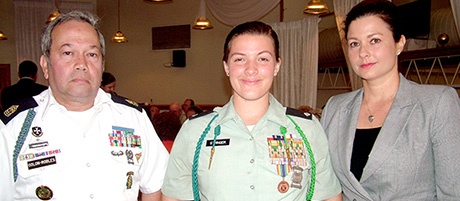
By Maria Sonnenberg
For Al Día Today

Like the dozen-plus cadets beside her, Isabella Stringer stood straight and proud as the Military Officers Association of America honored her and fellow cadets during an April ceremony at Patrick Air Force Base.
The Heritage High School senior and 12 other students from throughout Brevard, represent the crème de la crème of Brevard’s local Junior Reserve Officers Training Corps, or JROTC, which is offered as an elective at most local high schools.
Stringer, of Cuban-American descent, was joined by her mother, Hilda, and her JROTC instructor, First Sergeant Carlos Colon Robles. Only about 10 percent of the JROTC students at Heritage have a Hispanic background, said Robles.
A federal program sponsored by the United States Armed Forces in high schools across the country, JROTC is often mistakenly perceived by the general public as a recruiting tool.
“The majority of the students don’t go into the service,” said Colon Robles, who administers the Heritage program with retired Lieutenant Colonel Michael Dunning.
“This is not a boot camp. There are no expectations for students to go into the military. The program uses a military model to create a culture of discipline that instills self-confidence and prepares the students for college and careers. When colleges see that a student has JROTC in their background, they immediately look to them to be in leadership positions.”
According to government statistics, about a third of JROTC cadets go into the military. The true purpose of the program, which numbers 280,000-plus cadets at approximately 3,000 high schools across the United States, is “to instill in students in secondary educational institutions the values of citizenship, service to the United States, and personal responsibility and a sense of accomplishment.”
Of course, cadets who do choose to pursue a military career have an edge with JROTC, since enrolling in the course for three to four years while in high school can land the cadet a higher military rank upon enlistment.
The federal government subsidizes the cadets’ uniforms, equipment and textbooks, and pays for the salaries of the instructors, who, like Colon Robles, are typically retired military personnel.
Students meet for a class daily and participate in activities such as drill team, color guard, leadership lab, drum and bugle corps and physical education activities.
Each branch of the Armed Forces maintains a JROTC, so school programs are modeled after specific branches. For example, the JROTC program at Astronaut and Heritage High Schools is based on the Army, so ranking and uniforms mimic that branch of the military. At Eau Gallie and Satellite Beach High Schools, the JROTC program is based on the Air Force, while Bayside High School’s is Naby-based and Palm Bay High School’s is modeled after the Marines.
Honored with Cadet Stringer at the MOAA ceremonies were Cadets Tatiana Maldonado of Eau Gallie High School, Warren Lugo of Astronaut High, Indiaella Keemm-Pineiro of Merritt Island High School, Melik Sava of Viera High, Austin Duffell of Titusville High, Brittany Flanagan of Space Cast High, Ben Ripple of Satellite High, Rachel Bryant of Melbourne High, Charles Clifford of Cocoa Beach High, Sierra Seamans of Cocoa High and Nathaniel Barthelemy of Bayside High. Sea Cadet Briana Placena was also singled out by the Military Officers Association for honors, as was Florida Tech ROTC cadet Noah Vogel.
“JROTC serves to motivate young people,” said Colon Robles.

